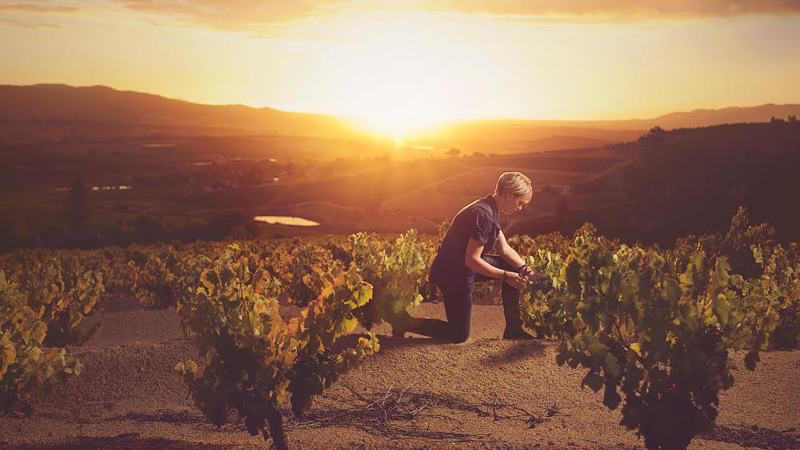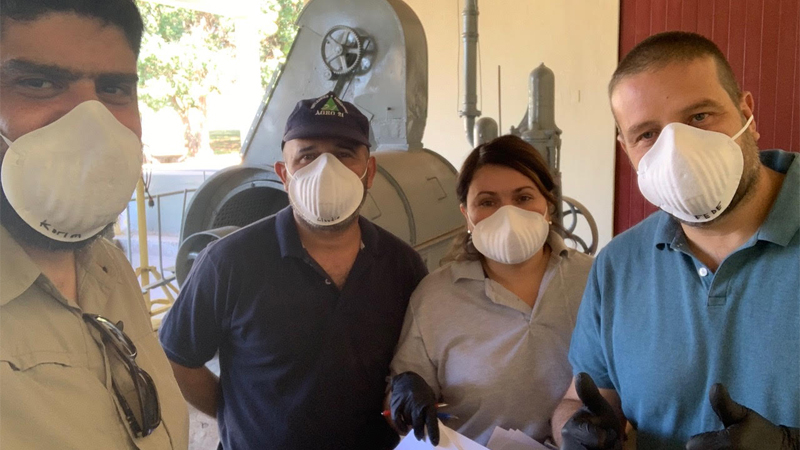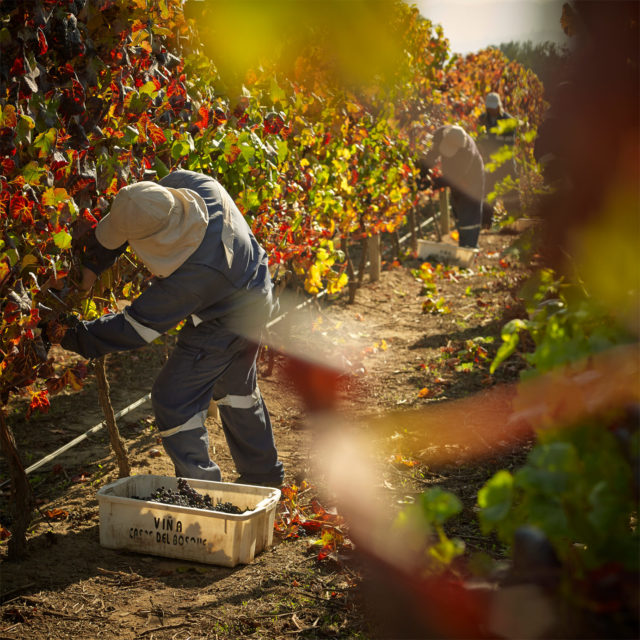Covid-19 is having a major and possibly devastating effect on the wine industry as a whole — tasting rooms across the globe are closed and many depend on visitation for sales — but it’s been especially difficult for wineries in the Southern Hemisphere, which also happen to be in the throes of wine’s most demanding season: harvest.
Winery operations in locked-down areas have been defined as essential, and thus the harvests throughout South Africa, New Zealand, Australia, and South America have been allowed to press on, although it’s far from business as usual. The pandemic is presenting unprecedented challenges during the busiest time of year as many wineries are forced to speed up their production despite a skeleton staff and a laundry list of safety protocols that effectively slows down their progress.
“All harvests are stressful,” said Paula Borgo, head winemaker at Bodega Séptima in Mendoza, Argentina. “We risk the year in a couple of months, but adding Covid-19 is one of the biggest challenges that life has put me in. I have 25 harvests carried out and I had never had to decide also on the health of the workers.”
A RUSH TO CRUSH
Time was on the side of many wineries in some Southern Hemisphere regions, like South Africa, which managed to harvest and crush most of their fruit before a lockdown was put in place. “We were very grateful to have all our grapes harvested and in our cellar,” says Corlea Fourie, vineyard and wine manager of Bosman Family Vineyards in Wellington, South Africa. Fourie added that her team was also able to get essential topping, barrel filling, and analyses done prior to South Africa’s 21-day lockdown. “We are in a lull as the 2020 harvest will be safe for the next few weeks. It will become problematic if the lockdown is extended as some critical wine actions will then be necessary.”

Several other winemakers acknowledged that, in retrospect, they were gifted with an earlier harvest this year, especially in Chile, where an especially hot and dry growing season resulted in harvest beginning two to four weeks earlier than usual. “What was first perceived as a complicated situation to handle ended up being a huge help in order to finish this harvest as soon as possible,” says Christian Blanc, managing director at Viña Casas del Bosque in Casablanca, Chile. His team is speeding up the process in an effort to get all of their fruit in the winery by Easter, and before the virus reaches its expected peak in Chile. “Because of this reason, the overall volume of fruit will go down, but we will not have any effect on quality,” he says.
Yet in cooler regions with slower ripening, if the grapes aren’t ready, they’ll simply need to stay on the vine. Winemaker Blair Walter at Felton Road in Central Otago, New Zealand, said that recent cooling temperatures after an unexpected early start to harvest have allowed his staff to slow down and make the best of a tough situation. While taking all the necessary social distancing and safety precautions, Walter said the crew is able to have “some longer, more contemplative lunches, and of course, accompanied by some mystery bottles.”
SHORT-HANDED HARVEST CREWS
For wineries that have managed to maintain their full harvest and cellar crews, the challenge is now to keep the number of workers gathered together in one space to a minimum. Some have divided their teams into smaller, rotating shifts, or have opted to machine harvest when they usually hand pick. Across the board, all non-essential and high-risk employees are working from home and most of the foreign harvest interns hired for the season have been sent back early to their respective countries. By creating a safer work environment, the consensus among winemakers seems to be that the days are a bit longer as tasks take more time to complete.
“It has actually been quite enjoyable and relaxed,” says Justin Van Wyk, winemaker at Constantia Glen in Cape Town, South Africa. “We are only harvesting with a skeleton staff that resides on the farm and as a result, we harvest smaller volumes of grapes per day and this makes it a lot more manageable for me in the cellar.”
Cautiously anticipating the worst-case scenario, Blanc, of Viña Casas del Bosque in Chile, says he’s operating with half the usual staff. “As you can imagine, harvest is not something we can stop, so we were forced to take some precautions to ensure our operation. We had to split our team in two different crews,” he says. “The B crew was sent ‘to the bench’ and they are working from home mainly on administrative issues, while the A team is actively working on harvest. The idea behind this is that if someone in the A team gets sick with Covid-19, then the whole A crew will have to go on quarantine and be replaced by the B team. Of course, it’s not very efficient, but there is no other way to ensure harvest.”
Blanc’s nightmare was nearly a reality at Distell in Stellenbosch, South Africa, where several employees had been in contact with an international visitor who got tested for Covid-19. “An international guest on site resulted in the red winemaker, one assistant, and the offloading team landing up in self-isolation until the test [came back] negative,” says Elize Coetzee, cellar master at Distell. “Three days at home during peak harvest, the stress levels were through the roof, but the remainder of the team stepped up and the job got done.”
EMPLOYEE SAFETY IS A TOP PRIORITY
A successful harvest is undoubtedly essential to a winery’s bottom line, but each winery VinePair spoke with insists that its No. 1 priority is the health and safety of its employees. Unfortunately, social distancing doesn’t exactly come easily in wine production. In the vineyard, for instance, workers sidle up next to and across from each other within the narrow rows to pick grapes, usually with just a few feet of distance between them. Then, as those grapes arrive at the winery for processing, there will often be multiple staff members lined up on either side of the sorting table, their hands overlapping as they reach for leaves and undesirable clusters.

But under the dark cloud of Covid-19, wineries have enacted a strict standard of protocols in both the vineyard and the cellar. Employees are instructed to remain six feet apart from one another, wear protective gear like masks and gloves, and wash their hands frequently. Sanitizing stations are set up throughout the winery, worker temperature checks are made upon arrival and departure, and daily safety briefings are conducted at the start of each shift. “Everyone has an individual alcohol spray to clean surfaces, tools, plugs, valves, pumps, and everything they touch,” says Karim Mussi, winemaker of several wineries and brands in Mendoza, Argentina, which include Bodega Altocedro and Bodega Alandes. “Every winery gate or door has a boot cleaning area with a disinfectant solution.”
At Bodega Garzón in Maldonado, Uruguay, managing director Christian Wylie says the company is handling the transportation of employees to and from the winery in order to minimize outside contact. At Bodega Séptima in Argentina, Bogro told VinePair that vineyard employees are now spaced one per row for harvesting. The company has also gone a step further, considering the mental health of its employees by arranging virtual sessions with psychologists for anyone who needs them during these uncertain times.
THE SHOW (ALWAYS) GOES ON
Covid-19 presents new challenges for vintners, but it’s certainly no worse than some of the catastrophes the industry has survived before, from extreme weather events to war to that vine-killing pest phylloxera, which nearly eradicated wine-making grapes in several countries in the 19th century.
“In Argentina, and especially in this business, we are well-trained storm pilots and we know how to manage a crisis,” said Mussi of Bodega Altocedro. “This harvest will prove, one more time, how beautiful and important this activity is, how many jobs it generates, and the strong-minded people needed to continue moving forward. No wars, or crises — and now a pandemic — can stop us.”
As for the quality of the wine, the virus is unlikely to define the 2020 vintage in the way that Mother Nature often does. As Wylie, of Uruguay’s Bodega Garzón, sees it, “We are grateful that, even with disconcerting news circulating, nature continues and the 2020 harvest has been the best we have had to date, with a dry year and cooler-than-usual temperatures yielding off-the-chart quality fruit.”
This story is a part of VP Pro, our free platform and newsletter for drinks industry professionals, covering wine, beer, liquor, and beyond. Sign up for VP Pro now!
